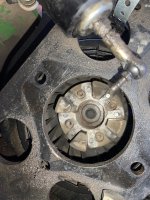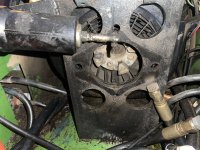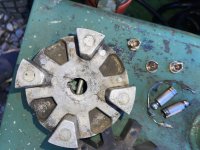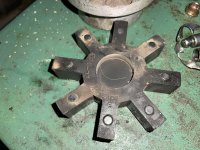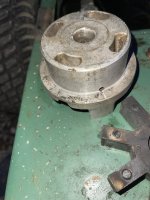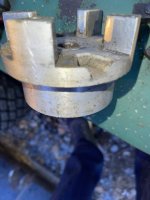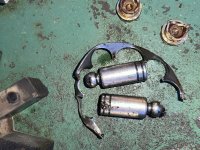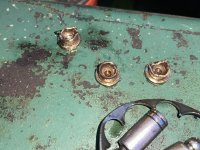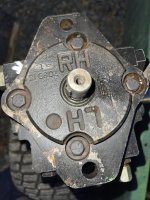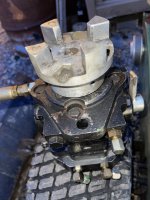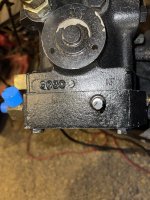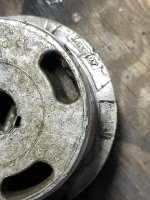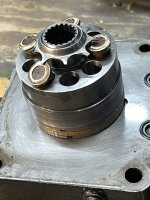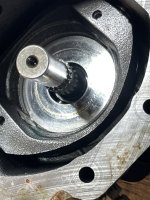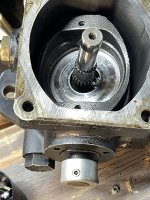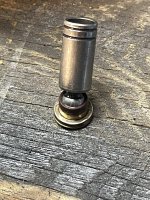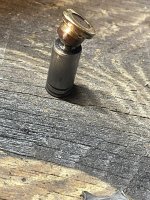You are using an out of date browser. It may not display this or other websites correctly.
You should upgrade or use an alternative browser.
You should upgrade or use an alternative browser.
More options
Who Replied?
/ 425 again…movement problems…
#121
Tchamp
Silver Member
Hmmm.... If you don't have one already, now's a good time to get an extra quick attach plate for the 425 and weld a 2" receiver tube to it. Slip in a ball hitch, and weld a 2" hitch socket on the backhoe. Use that to move it longer distances around your place.
The 2" receiver tube on a QA plate is really handy for other things as well.
You could use the PTAs a counter balance on the digger as well win-win
Tchamp
Silver Member
And:
That is the same pump used on the Scag hstm
I bought one of these use for parts for $350 and pull the pump off of it and send it to Terry and have them rebuild it for around $1000 and put on my 2425 last month so if you can get your hands on one of those With a bad motor or a bad deck or something like that that’s the same exact pump the only difference is is you might have to turn the face of the pump so it’ll pump in the right direction because on the Scagg it turns I think clockwise and on the machine on the PT it has to turn counterclockwise And all you have to do is on both the four bolts on the pump end and turn it 180° then put it back together. Just be sure when you install it on your 2425 or your 425 that your love joy couplinghas some play in a get like a little gap in between the two and it’s not putting pressure on the pump because it’ll destroy the pump ask me how I know lol. So if you wanna resurrect your machine, you can locate one of those and have a rebuilt or you can go to Scagg if you can get the part numbers for it and get one for about $3500. New.
ponytug
Super Member
Thanks for the postmortem photos. Sad, but i pressive, though I found it interesting to see. Fascinating: I had not expected the variable volume pump cylinders to be brass, nor for the Lovejoy to be in as good a shape as it was.And:
All the best,
Peter
Yes! I’m amazed at how good the rest of the pump looks inside. What I call the “swash plate” (that chrome ring that surrounds the shaft) just lays down in there and comes right out. You can see some “chatter” marks on it—I’d think it has to be perfectly smooth. That would probably be hard to find…Thanks for the postmortem photos. Sad, but i pressive, though I found it interesting to see. Fascinating: I had not expected the variable volume pump cylinders to be brass, nor for the Lovejoy to be in as good a shape as it was.
All the best,
Peter
With my basic experience, seems like just a few new pieces and it would be good again. LOL (if only it were that easy)
Those what I call “bullet” casings and the little gold caps attached, as well as the “retainer” ring and such…
I’ll have a few more pics later this evening.
oldnslo
Super Member
In looking at the pump failure I would suspect that loss of charge pressure was the cause along with elevated case pressure. If I recall correctly that pump is supplying oil to four wheel motors. If those motors have a case drain and one starts to fail it can cause low charge pressure.
Either way that pump needs some parts.
Either way that pump needs some parts.
“Loss of charge pressure” and the “case pressure”—could you teach me a little bit more by detailing what they are, and possible causes? Yes, it powers the 4 wheel motors.In looking at the pump failure I would suspect that loss of charge pressure was the cause along with elevated case pressure. If I recall correctly that pump is supplying oil to four wheel motors. If those motors have a case drain and one starts to fail it can cause low charge pressure.
Either way that pump needs some parts.
And yes,
We are definitely buying a new one, but I can’t just “walk away from this one”. As Terry advised, it’s not economical to spend a bunch of money on this problem, due to the age/hours, and the likelihood of more problems starting to pop up.
MossRoad
Super Moderator
- Joined
- Aug 31, 2001
- Messages
- 65,979
- Location
- South Bend, Indiana (near)
- Tractor
- Power Trac PT425 2001 Model Year
That year 425 doesn't have case drains on the wheel motors. Don't know about newer ones.In looking at the pump failure I would suspect that loss of charge pressure was the cause along with elevated case pressure. If I recall correctly that pump is supplying oil to four wheel motors. If those motors have a case drain and one starts to fail it can cause low charge pressure.
Either way that pump needs some parts.
